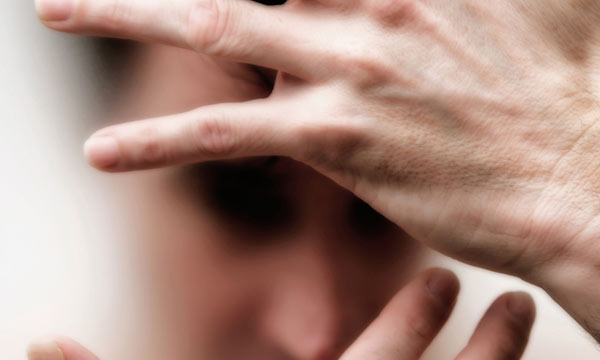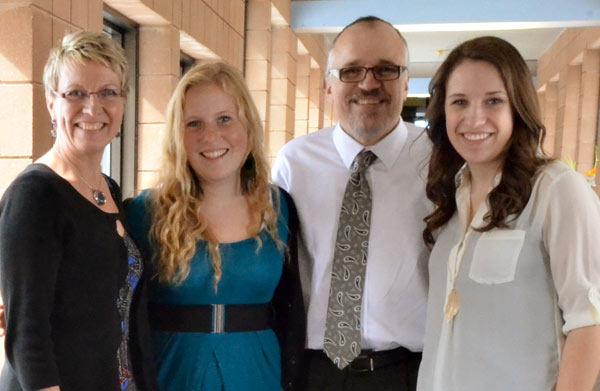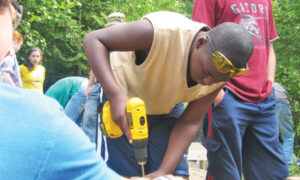It’s hard to imagine a force powerful enough to keep an academic from his books, a father from playing with his children, a husband from attending to the wife he loves. Rod and Susan Reynar of Olds need no imagination to describe this force because they walk the road of chronic pain every day. Rod has arachnoiditis, a neuropathic disease caused by inflammation of membranes around the spinal cord. The resultant binding of nerves and blood vessels causes incurable excruciating pain that often confines Rod to bed for months on end.
Surprisingly, though, the many struggles—since 2000, Rod has spent 10.5 years of his life in bed—have taken a backseat to the Reynars’ profound experiences of God in the depths of suffering. The story of the Reynar family is a glimpse into a unique experience of God’s love that offers incredible gifts of insight and challenge to the church as it seeks to respond to the journey of chronic pain.
Central to the Christian story is Christ’s death and resurrection. In spite of the obvious suffering in this story, however, Christians have always struggled to understand why it happens and how individuals and the church should respond. In the Book of Job, his friends assume he has sinned, and their well-intentioned attempts to fix him are misdirected and exasperating. In John 9:1-3, the disciples ask Jesus whose sin caused a man’s blindness. Jesus answers by saying the blindness happened so the work of God might be displayed.
While both well-known passages point away from blaming the victim, the issue of misunderstanding the cause of suffering still exists in faith circles. From his own experience, Rod says, “It is still there that we have, at some level, the prosperity gospel going. So what do you do with situations, how do you explain to yourself situations that seem so unconscionable. . . . Then when we pray for healing and it doesn’t happen, where is God? This is the elephant no one wants to acknowledge.”
The question “Where is God?” is clearly rhetorical for the Reynars. In the midst of deep suffering, they have been certain of Christ’s presence with them.
The Reynars’ story
Throughout his childhood, doctors dismissed Rod’s complaints as growing pains, while the fact of a tethered spinal cord remained unnoticed. After high school, constant pain confined him to bed for most of a year.
Rod describes a diagnostic myelogram, during which dye was injected into his spinal column, as one of the “most intensely painful three hours of my life. It’s likely the needle was pushed through my tethered nerves.” After the test, he says, “In an angry voice the doctor proceeded to tell my mom that all of my problems were in my head, all psychological.”
The next day he endured a psychological interrogation in his hospital room, with three roommates and their guests overhearing the whole thing. “What that does to an 18-year-old’s sense of confidence,” Rod muses of the humiliations. Over the next four years, he underwent three major back surgeries. “After the third surgery, I swore I’d never go back till I was crawling in, and that occurred 10 years later,” he says.
While the Reynars were expecting their second child and Rod was completing a doctorate of agriculture education degree at Penn State University, he learned the increasing pain was chronic and that he had arachnoiditis caused by a dye used in his myelogram. They were informed that Rod could expect to live the rest of his life with pain levels similar to the end stages of cancer, with one significant difference: there would be no end in sight.
“Everything came crashing to a halt,” Rod says.
A further surgery to finally un-tether his spinal cord went badly and key nerves were mistakenly severed, further increasing his pain and dysfunction. In 1997, unable to afford treatment in the United States and facing at least a year of recovery, the young family moved in with Rod’s parents in Calgary.
Not often realized is the impact chronic pain has on a person’s identity. This especially becomes an issue in a culture where self-worth is tied to material productivity. “Identity is wrapped up in what we do, and Rod isn’t ‘doing anything,’ ” Susan says of this time in their life.
When Susan was at home as a full-time caregiver, their daughters would avoid questions at school about what their parents did for a living. “Growing up, the only identity they have for us is that we are parents. Our girls still talk about that,” she says.
Rod describes the pain levels that kept him in bed with words like “burning,” “crushing” and “all-consuming.” On a scale of 1 to 10, he existed at a 9 for months on end. He could not concentrate, leave the house or engage well with his family. There were points when he was ready to commit suicide to escape the hellish torment.
Susan talked him out of it by reminding him that she and their daughters were an important reason to live and getting him to promise not to take his own life. “I knew I could not live in fear, I also knew Rod’s strength,” she says. “It was gut-wrenching, the hardest times for me, without a doubt.”
What the church did well
The Reynars are profoundly grateful for the church during their long journey in and out of hospital, in and out of bed, and always dealing with pain. After moving in with Rod’s parents, the Reynars immediately found a church community in Northwest Calgary.
“Foothills [Mennonite] Church was a place that embraced us, even though they knew we were transient,” Rod says. “They just kind of absorbed us.”
At the same time, Christian friends living far away offered to share their income so Susan could spend time with Rod and their children, instead of struggling to work outside the home while caring for them. Thousand-dollar cheques began arriving each month, with no strings attached and no desire for payback. “It was their way of saying they had too much and wanted to share,” Rod says.
In 1998, with pain levels sufficiently managed, Rod got his dream job as dean of agriculture at Olds (Alta.) College. The family moved to Olds and began attending Bergthal Mennonite Church. Rod’s job was doable from a wheelchair, it was exactly the career he had always wanted, and it allowed them to get by without financial help from their friends.
But after two years the pain worsened again and eventually work ate up every bit of Rod’s energy, leaving nothing for his family. Once more he was completely confined to bed. The regression was devastating.
“I went from an incredible job to living in bed, and experienced huge depression,” Rod says. “All dreams came to an end. [I was] suffering from levels of pain that made it difficult to have conversations. I could only visit for short periods of time, and there was no energy to put thoughts together. A brutal time. . . . Then many of my social groupings dissolved. There were many people that came directly after, but the number of people that maintained sustained contact with us were few and far between.”
Bergthal Mennonite removed a pew from its sanctuary to create room for a stretcher so Rod could participate in worship. When he served on church council, meetings were held at the Reynar home so he could participate.
“People at the church were good,” he recalls. “Sometimes this was the only outing I had. There was a cot at the front of the church. Very few people came up at first to talk with me, but that changed as people’s comfort level grew. It was such a gift when that began to happen.”
And the cheques in the mail resumed.
Responding to chronic pain
Churches are often adept in responding to acute stress, injury and loss. When illness or death occurs, there are established congregational protocols, as well as informal expectations for members to become involved. But chronic issues throw ideas of timeliness and appropriate response into chaos, and visitors are uncertain of how to be helpful.
“People don’t know how to deal with suffering,” Rod says. “Some people would come see me once, and I’d never see them at the house again.”
One of the problems for the family of a chronic sufferer is that they easily become cut off from their communities. Occasionally the family would not be informed of events, as it was assumed they would not be able to participate.
“It was all-consuming, so I often didn’t keep up with what was going on in the community,” Susan says of her caregiving role. “That was hard on me.” Sometimes people would visit Rod and tell him things, but Susan and the girls might be left out. “I heard a lot, but no one heard about my life, and I have one as well,” she says. “It was a gift when visitors came and not only talked about Rod’s experience . . . but also connected with me and the girls.”
It is difficult for individuals and the church to know how to respond to suffering when causes cannot be eliminated and there is no closure, not even death, on the visible horizon. Visitors often feel awkward and unsure of what is helpful.
“Sometimes we’d get so tired of people coming with verses lined up, or an anecdote of someone who was healed or [of] a wonderful doctor,” Rod says. “All I needed was their presence.”
Facing another person’s pain can bring up uncomfortable questions of our own vulnerabilities and failings, so they often avoid bringing up the really deep issues they carry with them into the room. That is a mistake, according to Rod. “People stay away because they don’t want to subject me to their questions, like ‘Who is God?’ and ‘Why?’ But it doesn’t matter, because I’m there already,” he says.
For Rod and Susan, the most important part of a visit wasn’t what a visitor did or said, but simply that they came. “Their physical presence there was saying in some way that I want to share your burdens, even though it makes me uncomfortable and raises a host of questions,” Rod says. “I can never underestimate the presence of another person, that they are willing to come in and take that on, to try to understand, with no agenda to fix it.”
According to the Reynars, an issue for the church is accepting the reality that stepping into the life of someone who is suffering is a lifetime commitment. “There are no time boundaries on it and [the church needs] to accept that,” Rod says.
Learning from suffering
A unique opportunity that may come with the experience of chronic pain is the time to reflect deeply upon life’s meaning and mysteries. Rod and Susan could understandably be bitter about the curves life has pitched them, but, instead, they have learned to be profoundly grateful to God and peaceful in responding to people.
An important gift helping Rod to deal with his situation came through a pain specialist who introduced him to meditation. Through meditation, Rod began to find ways to cope, and even thrive, in the midst of crippling pain. Meditation became like going to work each day, a discipline of deeply listening for God and reframing his attitude and outlook.
“The work of my day [is to] deal with the suffering,” Rod says. “Each and every day I have to turn away from the temptations to be angry, bitter and furious, and, instead, to reach out to myself and others in love.”
Prayer was, and is, a crucial part of Rod’s coping with pain and is a conduit for the healing touch of God. Through prayer, Rod works to give himself over into God’s hands. The example of Jesus praying in the Garden of Gethsemane and relinquishing control to God is important to Rod and Susan. “Prayer is just fundamentally being in touch with God,” he says.
They also experienced the communal gift of healing prayer when a pastor and two men from Foothills Mennonite came during a particularly desperate time. “The wind moved through our house when they prayed,” Rod says.
Developing deep graciousness towards others has helped the Reynars deal with feelings of disappointment when people did not come and they faced feelings of being forgotten. “What has helped me through those moments,” Susan shares, “is having no expectations. Then, when someone comes, it’s always a gift.”
Moving forward
In 2011, Rod’s arachnoiditis became progressively worse, confining him to bed for 18 straight months. The situation precipitated a trip to the Netherlands, where he received a special implant to help control his pain. The procedure was a success, and today he is once again on his feet and able to engage in life outside the home.
During this time of reprieve, Rod and Susan look forward to re-engaging with family, the church and various communities, and to do some volunteer work. In August, they will move to Winnipeg, where Rod has accepted a volunteer teaching position in sociology at Canadian Mennonite University (CMU).
Moving and resettling are challenges, and come with some mixed feelings for the Reynars; however, the chance to engage academically with the church is an invigorating and exciting opportunity for Rod.
It is not the physical release, however, that is most important to him. “Had I been physically healed, and only physically, I would be a miserable man,” he says. “The redemption that I feel in my life is not tied to the implant that was done. The redemption that we feel now started years ago and, although the last two years took me to the absolute brink of my physical existence, . . . I am profoundly thankful for the last two years because of how God’s redemptive grace has been shown in my life and felt by me. [The implant] has transformed my life, but God has redeemed it.”
Donita Wiebe-Neufeld, co-pastor of First Mennonite Church, Edmonton, blogs at http://fmclectionary.blogspot.ca. Her April 30, 2013, post, “Pick up your mat . . . and what?’ is about writing this feature article.
See also: “Tips for giving—and receiving—visits in the midst of chronic suffering”









Leave a Reply
You must be logged in to post a comment.